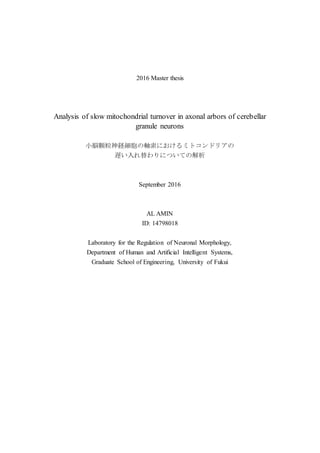
Summary of research
- 1. 2016 Master thesis Analysis of slow mitochondrial turnover in axonal arbors of cerebellar granule neurons 小脳顆粒神経細胞の軸索におけるミトコンドリアの 遅い入れ替わりについての解析 September 2016 AL AMIN ID: 14798018 Laboratory for the Regulation of Neuronal Morphology, Department of Human and Artificial Intelligent Systems, Graduate School of Engineering, University of Fukui
- 2. Abstract Proper distribution of mitochondria within axons and at synapses is critical for neuronal function. Mitochondria move bidirectional, pause briefly, and move again, frequently changing direction. It has been reported that most of mitochondria in axon are in the stationary state by anchoring to the microtubules. However, mechanisms by which anchoring/displacement of stationary mitochondria remain largely unknown. In this study, I genetically labeled mitochondria and performed time lapse imaging of mitochondria in axons of primary cultured cerebellar granule neurons. I found that about 84% mitochondria are present as stationary state. Importantly, I found that they undergo turnover and most of mitochondria change their position within a few hours. I also quantified the turnover of mitochondria in between young (5 days in vitro, DIV) and old (10 DIV) CGNs and found that there is no significant difference. Furthermore, I found that turnover rate of stationary mitochondria is not dependent of the branch length. Together, I found the slow turnover of stationary mitochondria in axon, which is not affected by neuronal maturation and branch-dependent regulation at least in cultured CGNs. I think my present study will be valuable to understand the systems that coordinately regulate mitochondrial quality and distribution.
- 3. Table of contents 1. Introduction and Background 1-1. Over view ..................................................................................1 1-2. Nerve cells ..................................................................................1 1-3. Cerebellar granule cells ..................................................................................2 1-4. Microtubules ..................................................................................3 1-5. Regulation of axonal mitochondria ...................................................................4 2. Experimental Methods 2-1. Cerebellar granule cell culture ..................................................................................3 2-2. Gene transfer by the calcium phosphate method ...................................................7 2-3. Time-lapse observation using a fluorescent microscope ....................................9 2-4. Image Analysis by using imageJ software ...................................................9 2-5. Composition of the reagents ..................................................................................10 2-6. Flowchart of the experiments ..................................................................................13 3. Results 3-1. Quantification of stational vs. motile mitochondria in CGN axons .....................14 3-2. Detection of turnover of stationary mitochondria in CGN axons .....................16 3-3. Comparison of turnover of mitochondria in young vs. old CGN axons .....................18 3-4. Analysis of region dependent difference of stationary mitochondria in CGN axonal arbors ..................................................................................20 3-5. Analysis of region dependent difference in the turnover of stationary mitochondria in CGN axons ..................................................................................23 4. Discussions ..................................................................................25 5. Acknowledgments ..................................................................................26 6. References ..................................................................................27